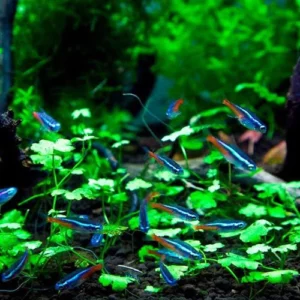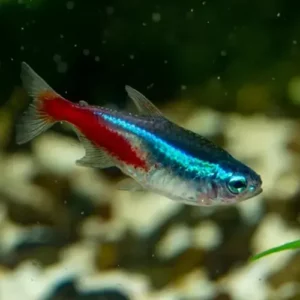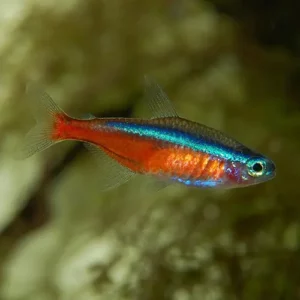Are Neon Tetras Aggressive? No, and Why
Neon tetras are inherently not aggressive creatures. Their peaceful nature is largely influenced by their schooling behavior, which offers safety and encourages communal interactions. The small size and lack of aggressive features make them less inclined towards confrontations. Evolutionarily, they’ve been conditioned for evasion rather than aggression, given their place in the natural food chain. In a properly managed aquarium—having ample space, a sizable school of fellow tetras, and compatible tank mates—their tranquility further shines. Mismanagement, like cramped spaces or unsuitable companions, can stress them, but by nature, they lean towards harmony over hostility.
Home » Guides » Fish Care » Neon Tetra » Are Neon Tetras Aggressive? No, and Why
Neon Tetra Fact Sheet
| Scientific Name | Paracheirodon innesi |
| Common Name | Neon Tetra, Neons |
| Care Difficulty | Easy |
| Life Expectancy | 3-10 Years |
| Average Size | 1.5 Inches (3.8cm) |
| Temperature | 72°F – 82°F (22°C -28°C) |
| Diet | Omnivore |
| Behavior | Friendly/Peaceful |
| Breeding | Medium/Hard |
| pH | 6-7.5 |
| Live Plant Friendly | Yes |
The Generally Peaceful Nature of Neon Tetras

Schooling Behavior
Neon tetras are like the dazzling stars of the freshwater aquarium universe. Much like how stars cluster together in constellations, neon tetras naturally exhibit schooling behavior. So, what’s all the fuss about schooling, and how does it play into their peaceful nature?
- Safety in Numbers: In the vast expanse of their natural habitats, neon tetras are small fish in a very big pond, making them easy targets for larger predators. Schooling offers protection. The combined movement of a school can disorient predators, making it challenging to single out and target an individual tetra.
- Social Creatures: Neon tetras are inherently social fish. They derive comfort from being with their kind. In a school, they communicate and synchronize their movements, creating a breathtaking underwater display of unity and coordination.
- Reduced Aggression: Now, here’s the magic of schooling! By nature, fish within a school rarely display aggression towards one another. The shared purpose of the school—to stay safe, find food, and simply exist harmoniously—creates an environment of mutual respect. As they swim together, any aggressive tendencies are dulled, focusing more on the collective rather than individual disputes.
- Natural Instinct: For neon tetras, schooling isn’t a learned behavior—it’s instinctual. From the moment they’re born, these little fish are drawn to the group, making it a deeply ingrained aspect of their nature.
Size and Physical Capabilities
Neon tetras, with their modest size and delicate physique, are undeniably among the more petite members of the freshwater community. But how does this impact their behavior?
- Tiny, Not Terrifying: The neon tetra’s small stature, generally reaching up to 1.5 inches in adulthood, makes it less likely to be the “big fish” in the tank. Their diminutive size means they’re not built to be bullies. Instead, they rely on their wits and agility to navigate their environment.
- Absence of Aggressive Features: Unlike some of their piscine peers, neon tetras don’t possess the pronounced teeth, powerful jaws, or other physical traits typically associated with aggressive fish. Their build is more about grace and less about grit.
- A World Built on Evasion: In the grand tapestry of the aquatic world, neon tetras are more the prey than the predators. Their physique is designed for quick, evasive actions rather than confrontations. Their slim, streamlined bodies allow for swift movements to escape any looming threats.
- Coloration as Camouflage: Their iconic neon stripe isn’t just for show. In the dappled light of their natural habitats, this stripe can act as a form of camouflage, breaking up their silhouette and making it harder for predators to single them out. It’s a survival feature, not an aggression signal.
Evolutionary Traits
To truly grasp the neon tetra’s gentle nature, we need to drift back to the waterways of South America, their native realm, where evolution has shaped their behavior over millennia.
- Amazonian Origins: Neon tetras hail from the clear streams and blackwater rivers of the Amazon Basin. These waters are a dense tapestry of plants, fallen leaves, and a myriad of hiding spots. In such an environment, evasion and camouflage take precedence over aggression.
- Dappled Light Play: The thick rainforest canopy above their natural habitats casts a mosaic of light and shadow on the water. Neon tetras, with their iridescent stripe, use this to their advantage, blending seamlessly into the surroundings. When you’re good at hiding, there’s little need to be confrontational.
- A Diet of Peace: Being micro-predators, neon tetras primarily feed on minuscule invertebrates and tiny crustaceans. Such a diet doesn’t necessitate aggressive hunting strategies. It’s more about a keen eye and a quick dash, rather than overpowering prey.
- Safety Over Territory: In the vast expanses of their native waterways, there’s plenty of space for everyone. Instead of being territorial, neon tetras prioritize sticking together and staying safe. Their evolutionary path has emphasized community over combat.
- Predation Pressure: With plenty of larger fish lurking in the shadows, neon tetras have always been more focused on staying off the menu rather than picking fights. This constant threat has instilled in them a behavior of caution and camaraderie.
Understanding Neon Tetra Aggression

What Constitutes Aggression in Fish?
At first glance, our finned friends might appear serene as they glide effortlessly through the water, but just like any creature, they too have moments of discord.
To the untrained eye, playful frolicking or simply hunting for food can often be mistaken for aggressive behavior. However, there are specific signs that are commonly accepted as markers of true aggression among fish.
- Chasing: You know that one fish that always seems to be on the tail of another? This isn’t a friendly game of tag; more often than not, it’s a form of aggression.
- Nipping: Those little bites or snaps at other fish’s fins or body are, unfortunately, not signs of fishy kisses. Nipping is a clear indication of aggressive intent.
- Flaring Gills: Just as a cat might puff up to seem bigger, some fish flare their gills to display dominance or displeasure. If you see this, you’re witnessing a sign of an annoyed or threatened fish.
- Mouth Locking: No, they’re not trying to share secrets or have a passionate moment. This behavior is a physical contest, a sort of arm-wrestling match to establish dominance.
- Body Color Changes: In the realm of fish, mood swings often come with a change in appearance. Darkening colors, in particular, may signify stress or aggression.
- Territorial Displays: Each fish has its own little piece of the underwater world it calls home. If you notice a fish constantly hovering in one spot and chasing away any intruders, they’re probably guarding their claimed territory.
It’s worth noting that not all displays of aggression result in physical harm. Sometimes, it’s all about posturing and show. However, it’s still essential for aquarists, whether novices or experts like us, to recognize these signs. A peaceful tank is a happy tank, after all!
Common Causes of Neon Tetra Aggression
Fish, much like us humans, aren’t aggressive without a reason. There are certain triggers and circumstances that can cause our water-bound buddies to show their feisty side.
- Territorial Disputes: Imagine having someone constantly enter your room without knocking. You’d be a bit miffed, right? Fish, especially the more territorial species, are very protective of their claimed spaces in the aquarium. When another fish swims into this space, the original occupant might lash out to protect its territory.
- Mating Rituals: The dance of love isn’t always smooth sailing in the aquatic realm. Males can become aggressive as they compete for the attention of females. At times, they might even display aggression toward the females, urging them to accept their courtship. It’s quite the underwater drama!
- Competition for Food: Food is a primal need, and in the aquatic world, it’s a limited resource. If a fish feels another is horning in on its meal, it might turn aggressive. This is nature’s way of ensuring survival; the hungriest and most determined often emerge victorious in these skirmishes.
- Introducing New Fish: Bringing a new fish into an established tank can be like throwing a wrench into a well-oiled machine. The original inhabitants might view the newcomer as an intruder, leading to aggression as they re-establish dominance hierarchies.
- Stress: Just like how we might snap when we’re stressed, fish too have their breaking points. Stressors like poor water quality, inadequate hiding spots, or constant disturbances can make even the most placid fish turn aggressive.
- Mismatched Species: It’s not just about size or dietary needs. Some species have natural animosities or differing behaviors. Placing incompatible species together can be like trying to mix oil and water – it’s bound to cause friction.
Reasons for Neon Tetras Peaceful Nature

Natural Habitat and Predators
Delving into the neon tetra’s role in the intricate web of life gives us a profound understanding of their serene demeanor. They’ve evolved not as fearsome predators, but as masters of evasion and survival.
- Position in the Food Chain: In the bustling aquatic world of the Amazon, neon tetras are not apex predators. Far from it. These glimmering fish sit somewhere in the middle, feasting on smaller invertebrates while evading larger, hungry eyes. It’s a delicate balance of eat-and-be-eaten.
- Masters of Evasion: Nature, in her endless wisdom, didn’t arm neon tetras with fearsome fangs or powerful pincers. Instead, she gifted them with agility, speed, and the art of camouflage. Their radiant stripe and rapid reflexes are their shields against a world full of potential threats.
- Predators Lurking: From cunning cichlids to patient piranhas, the Amazon teems with creatures that wouldn’t mind a neon snack. For tetras, every ripple could be a potential threat. Such constant vigilance has molded them into creatures of caution, ever watchful and always ready to dart away.
- A Life of Adaptation: Their natural habitats, be it clear streams or blackwater rivers, undergo seasonal changes. Floods can expand their territory, while the dry season can shrink it. In such ever-changing landscapes, aggression is a luxury. Adaptability and cohesion become vital survival traits.
- Safety in Shoals: When the world is brimming with bigger fish with bigger appetites, there’s wisdom in numbers. Schooling isn’t just for show; it’s a defense mechanism. The synchronized movement of a neon tetra school can confound predators, making it hard to target a single individual.
Social Cohesion in Schools
Neon tetras, much like a finely tuned orchestra, find strength and harmony in unity. The way they come together in schools is not just an aesthetic marvel but also a beautiful testament to their evolutionary wisdom.
- Collective Consciousness: While it may seem like a synchronized dance to the onlooker, neon tetras in a school operate with a collective consciousness. They are hyper-aware of their neighbors, adjusting their movements in real-time to maintain cohesion. This is not merely for show; it’s a survival tactic honed over millennia.
- Minimized Competition: Instead of constantly competing with one another for resources, neon tetras in schools often share the bounty. Their social structure isn’t about dominance but about equitable distribution. When food abounds, it’s a shared feast, reducing the potential for in-fighting.
- Emotional Comfort: Believe it or not, fish have feelings too! For neon tetras, being part of a school provides a sense of security and emotional well-being. Lone neon tetras can exhibit signs of stress, while those in schools exhibit more vibrant colors and active behaviors – a clear sign of fishy contentment.
- Role Distribution: Within the school, neon tetras often adopt different roles. Some serve as lookouts, others as foragers, and some might even play the role of ‘guides’ for the school’s movement. This subtle division of roles further reduces potential conflicts, as each fish has a purpose.
- Consensus Over Confrontation: Decisions within the school, be it changing directions or finding a resting spot, are often made collectively. Instead of one dominant figure leading the way, the school moves and acts based on a shared consensus. This democratic approach fosters harmony and minimizes aggression.
Breeding and Mating Rituals
In the sprawling tapestry of the fish world, neon tetras bring a touch of delicacy and romance. Their mating rituals, in stark contrast to some of the more aggressive species, are gentle and largely devoid of aggressive territorial behaviors.
- Twilight Romance: Neon tetras prefer subdued lighting for their mating dances. The dim light of dawn or dusk provides the perfect ambiance for courtship. In such gentle illumination, males display their vibrant colors and elegant moves to woo potential partners.
- Gentle Pursuit: Instead of aggressive chases or confrontational displays, neon tetra males tend to approach females with a series of subtle gestures. A flick of the fin here, a gentle circle there – it’s a gentle ballet of admiration rather than a fervent display of dominance.
- Spawning Sites: When it comes to choosing a place for laying eggs, neon tetras don’t fiercely defend territories. Instead, they seek out quiet, plant-covered corners of the aquarium or their natural habitat. Soft plants or moss become the nurturing cradle for their future offspring.
- Absence of Territorial Squabbles: Unlike some fish species that might engage in fierce battles over prime spawning sites, neon tetras tend to be more collaborative. Multiple pairs might spawn in proximity without significant conflict. The focus is on nurturing the next generation rather than staking claims.
- Community Parenting: Post-spawning, neon tetras don’t guard their eggs with zealous aggression. Instead, they rely on the safety of their habitat and the community to ensure the well-being of the eggs. It’s a more collective approach to parenting, which might seem risky but aligns with their peaceful nature.
Frequently Asked Questions – FAQ
Give Us Feedback
Please help us get better by making suggestions or giving feedback, we really do listen to it!



